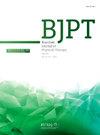How do foot-ankle exercises improve clinical and plantar pressure outcomes in people with diabetic peripheral neuropathy? A mediation analysis of a randomized controlled trial
IF 3.2
3区 医学
Q1 ORTHOPEDICS
引用次数: 0
Abstract
Background
Foot-ankle exercises targeting modifiable risk factors, such as peak pressure, ankle motion, and foot strength, may reduce ulcer risk and improve gait biomechanics, but the pathways driving these improvements are unclear.
Objectives
To identify the causal pathways through which a 12-week foot-ankle exercise program improved foot function, pain, and plantar pressure during gait by examining key mediators of these effects.
Methods
A total of 62 participants with diabetic peripheral neuropathy (DPN) were assigned to either a web-based foot-ankle program or usual care. The outcomes included peak pressure, pressure–time integral at the forefoot, foot pain, and foot function. Mediators included hallux and toe strength, sagittal ankle range of motion (ROM) during gait stance phase, ankle plantar flexion angle at push-off, ankle extensor moment at push-off, and foot pain and function. Outcomes and mediators were assessed at baseline, 12 weeks, and 24 weeks. Mediation models were tested using ordinary least squares regression with bias-corrected bootstrap confidence intervals.
Results
The analysis revealed consistent and inconsistent mediation effects. Improvements in foot function were mediated by reductions in foot pain (1.71, 95 % CI: 0.21, 4.43) and increases in ankle plantar flexion angle at push-off (0.45, 95 % CI: 0.15, 0.74). While the intervention directly reduced forefoot peak pressure, inconsistent mediation occurred, with indirect increases through reduced foot function (3.84, 95 % CI: 1.04, 11.38). Consistent mediation was observed, with increased sagittal ankle ROM during gait stance phase (9.02, 95 % CI: 2.47, 17.68) mediating a rise in the forefoot pressure-time integral.
Conclusion
The program reduced pain, improved function, and influenced plantar pressure through mediated pathways, highlighting a complex interplay of consistent and inconsistent mediation effects.
足踝运动如何改善糖尿病周围神经病变患者的临床和足底压力结局?随机对照试验的中介分析
背景:针对可改变的危险因素,如峰值压力、踝关节运动和足部力量进行足踝锻炼,可能降低溃疡风险并改善步态生物力学,但推动这些改善的途径尚不清楚。目的通过检查这些影响的关键介质,确定12周足踝运动计划改善足功能、疼痛和步态时足底压力的因果途径。方法共有62名糖尿病周围神经病变(DPN)患者被分配到基于网络的足踝项目或常规护理中。结果包括峰值压力、前足压力-时间积分、足部疼痛和足部功能。调节因子包括拇趾力量、步态站立阶段矢状关节踝关节活动度(ROM)、蹬离时足底屈曲角度、蹬离时踝关节伸肌力矩以及足部疼痛和功能。在基线、12周和24周时评估结果和中介因素。使用普通最小二乘回归和偏差校正的自举置信区间对中介模型进行检验。结果分析显示中介效应一致和不一致。足部功能的改善是通过足部疼痛的减轻(1.71,95 % CI: 0.21, 4.43)和蹬离时踝关节足底屈曲角度的增加(0.45,95 % CI: 0.15, 0.74)介导的。虽然干预直接降低了前足峰值压力,但中介作用不一致,通过降低足功能间接增加(3.84,95 % CI: 1.04, 11.38)。观察到一致的中介作用,步态站立阶段矢状面踝关节ROM增加(9.02,95 % CI: 2.47, 17.68)介导前足压力-时间积分升高。结论:该方案减轻了疼痛,改善了功能,并通过介导途径影响足底压力,突出了一致和不一致的中介作用的复杂相互作用。
本文章由计算机程序翻译,如有差异,请以英文原文为准。
求助全文
约1分钟内获得全文
求助全文
来源期刊
CiteScore
6.10
自引率
8.80%
发文量
53
审稿时长
74 days
期刊介绍:
The Brazilian Journal of Physical Therapy (BJPT) is the official publication of the Brazilian Society of Physical Therapy Research and Graduate Studies (ABRAPG-Ft). It publishes original research articles on topics related to the areas of physical therapy and rehabilitation sciences, including clinical, basic or applied studies on the assessment, prevention, and treatment of movement disorders.

 求助内容:
求助内容: 应助结果提醒方式:
应助结果提醒方式:


